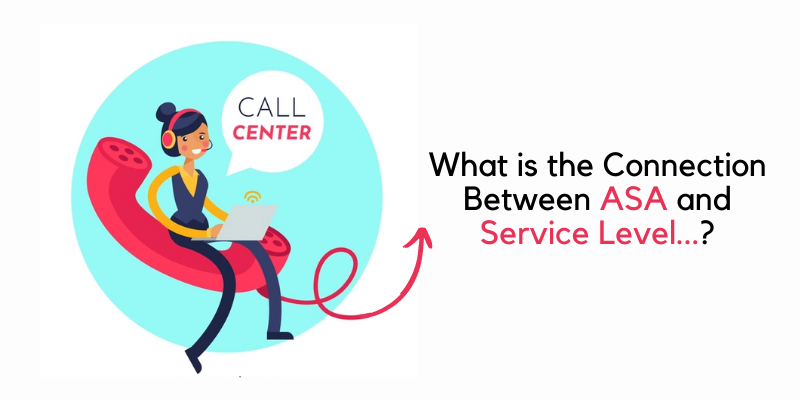
In a call center, customer experience matters most. A satisfied customer means the business is going in the right direction. And, in today’s day and age, contact outsourcing is very important to handle customers over calling.
A contact center provides superior quality calling solutions for both i.e. inbound calls and outbound calls. If you have ever experienced call center solutions, you probably also experienced their services closely.
And, may hear the term, ASA and Service Level. But what do they really mean?
In this blog, we’ll explore the connection between ASA and Service Level and will also look into some hacks to improve it better.
The call center uses several KPIs to measure the success and performance of businesses and agents, respectively. Among many, ASA and Service Level are arguably the most important ones.
What is Service Level?
Simply, Service Level refers to the measurement of the performance of a service given by an agent in a call center. The service level is expressed in numerical expressions, in percentage.
For example, a contact center with an 80/20 service level answers 80% of calls within 20 seconds.
Service level is displayed as two numbers – the first number i.e. 80 indicating the percentage of calls answered. The second number i.e 20 indicating the target time in seconds.
Additionally, the service level refers to the achievement of specific goals as mentioned below:
- Percentage of calls answered in a call center.
- The percentage of customers holding time on a call.
- Percentage of all parts of an order being fulfilled completely.
It is important to steady the service level for better results. If an agent takes a long time to answer the call or is put on hold for a long time, it surely disturbs the customers and left in dissatisfaction.
The best way to keep the service level optimized is through motivating the agents or bringing gamification into the action.
What is ASA?
ASA stands for Average Speed of Answer, is a part of service level and a kind of KPI as well. It is referred to as the average wait time callers spend on hold or waiting for the agent to speak with him/her.
Generally, ASA is represented in seconds. For instance, 10 seconds, 20 seconds, and so on.
It is not denied that long waiting-time or long hold times result in frustrated customers. That is why it counts as the top-prior metric of call centers to manage.
How It is Measured? With An Example
There are no multiple manners or formulas to calculate ASA. There is only one and mentioned below.
ASA is calculated by:
ASA = Total Wait Time for Answered Calls/Total # of Answered Calls.
Imagine you call customer care to speak with an agent for a solution. The moment the IVR puts you on hold before the agent speaks to you is referred to as the frequency of answering calls.
In other words, the time taken by an agent to answer or connect to the connect is called ASA.
Why Is Average Speed of Answer Important?
It is important from the two aspects…!
First, ASA is important because it gives call center agents the information and tools they need to do their jobs effectively.
Second, it has a relationship with the Interactive Voice Response System which notifies the agent to be prepared to receive a call.
How Are ASA and Service Level Connected?
The Average Speed of Answered Calls and Service Level are important metrics to consider for a call center. These metrics offer specific results when measured in terms of performance.
Like, the Service level is a niche for indicating how efficiently and quickly your agents are addressing customer customers while ASA indicates the time taken to respond the customer concerns.
They are different so much, in fact, they both impact each other to a great extent. How?
For example, an 80/20 service level is a strong service level. But if your ASA is high — say, 20 seconds — it means there’s a big deviation in service quality for your remaining 20% of callers.
Also, a lower service level will naturally reduce your ASA, so it’s important to keep these two metrics running in parallel.
Tips for boosting your Service level and ASA
Well, it is not hard to observe where your agent falling or being a cause for unproductive results. Using KPIs you can instantly figure out the performance and their production rates and in this way, you can plan your strategies to achieve better results.
Here are some tips you can consider in time of need when facing lower agents’ productivity concerning Service Level and Avg. Speed of Answering Calls.
Tip#1: Call volume forecasting.
Look into your past data and analyze call volume trends. Check for the consistent spikes using periodic filters – day, week, month, and year.
Tip#2: Strategic staffing
When you look into data history, you would be able to identify certain peek times and be able to align your staffing efforts. This would also help you in knowing which agent is available during busy times.
Tip#3: Call-back technology
Call back technology is a brilliant solution to optimize Service level and Average Speed of Answer. It saves you in times of crisis i.e. leads ineffective management of bulk calls. This also eliminates callers waiting on hold and enhances the customer experience.
Also Read: Tips to Enhance Customer Experience During Lockdown
In the end, it is not enough to simply rely on percentages. Proper measurement and adaptable strategies should consider outliers.
Answering calls and providing solutions should not be the ultimate target of agents. They should work upon bringing efficiency in calling, communication, and speed. They should also be concerned about the customer experience across their entire journey.
Leave a Reply
